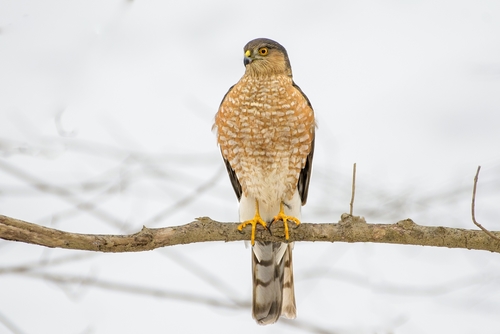
Sharp-shinned Hawk
The Sharp-shinned Hawk (*Accipiter striatus*) is a small, agile raptor found throughout North and South America. It is known for its incredible speed and maneuverability in forested environments, making it a highly effective predator of smaller birds. As a key component of the avian ecosystem, it helps regulate songbird populations. Culturally, it is sometimes seen as a symbol of agility and precision, though it doesn't feature as prominently in folklore as some larger raptors.
23-37 cm
Length
42-68 cm
Wingspan
Least Concern
Conservation Status
Distribution
The Sharp-shinned Hawk has a broad distribution, ranging from Alaska and Canada, through the United States, Mexico, Central America, and into parts of South America. Migratory populations breed in northern regions and winter in the southern U.S., Mexico, and Central America. Altitudinal range extends from sea level to over 3,000 meters.
Lifespan
Up to 10 years in the wild, although average lifespan is likely shorter. Captive birds may live longer.
Sharp-shinned Hawk's Habitat
Habitat Types
Coniferous forests, Deciduous forests, Mixed woodlands, Riparian woodlands, Suburban areas with sufficient tree cover
Climate Zones
Boreal, Temperate, Subtropical, Tropical (at higher elevations)
Adaptations
Their short, rounded wings and long tail provide exceptional maneuverability in dense forests, allowing them to pursue prey through thick vegetation.
Variations
Several subspecies are recognized, differing slightly in size and plumage coloration. For example, *A. s. velox* is the most widespread North American subspecies, while *A. s. fringilloides* is found in Cuba.
Appearance
Breeding Plumage
Adult plumage is similar year-round. Juveniles have brown upperparts and streaked underparts.
Seasonal Feather Changes
Minimal seasonal variation in adults.
Sex Based Plumage Differences
Adult males have bluish-gray upperparts and reddish-orange barring on the underparts. Females have brownish-gray upperparts and less vibrant barring.
Notable Features
Long, square-tipped tail with dark bands., Short, rounded wings., Relatively small head., Sharp, hooked beak., Yellow to orange eyes (adults).
Diet and Feeding
Primary Foods
Small birds (e.g., sparrows, warblers, thrushes), Small mammals (occasionally), Large insects (occasionally)
Foraging Behavior
Sharp-shinned Hawks are ambush predators, often perching concealed in trees and waiting for prey to approach. They also pursue prey in rapid, agile flight, using their maneuverability to navigate through dense vegetation. They frequently hunt around bird feeders.
Specializations
Their long legs and toes are adapted for catching and holding small birds in flight.
Seasonal Diet Variations
Diet may shift slightly depending on prey availability. During migration, they may take advantage of concentrated songbird flocks.
Behavior
Social Structure
Generally solitary or in pairs during the breeding season. May form small, loose flocks during migration.
Communication
High-pitched 'kik-kik-kik' calls., Screams and whistles., Visual displays (e.g., tail-fanning).
Migration
Many populations are migratory, traveling long distances between breeding and wintering grounds. They often follow coastlines and mountain ranges.
Territorial or Group Behaviors
Highly territorial during the breeding season, defending their nesting area from other raptors and potential predators.
Conservation
Threats
Habitat loss (deforestation), Collisions with windows and vehicles, Pesticide exposure (indirectly through prey), Climate change (potentially affecting prey availability and migration patterns)
Protection Programs
Migratory Bird Treaty Act (in the U.S.), CITES Appendix II (regulates international trade)
Local National Laws
Protected under various state and provincial wildlife laws.
Population Trend
Stable
Population Estimates
Global population estimated at 1.5 million individuals.
Interesting Facts
They are one of the smallest hawks in North America.
Their small size allows them to be highly agile hunters.
Females are significantly larger than males, a phenomenon known as reverse sexual dimorphism.
This is common in many raptor species, and may be related to the female's role in incubation and protecting the nest.
They are sometimes called "Sharpies" by birdwatchers.
This is a shortened, informal name.
Faqs about Sharp-shinned Hawk
What should I do if I find an injured Sharp-shinned Hawk?
Do not attempt to handle the bird yourself. Contact a local wildlife rehabilitator or veterinarian. Raptors have sharp talons and beaks and can cause injury.
Are Sharp-shinned Hawks dangerous to humans?
No, they are not dangerous to humans. They are shy and avoid human contact. They may defend their nests aggressively if approached too closely.
Do Sharp-shinned Hawks eat hummingbirds?
While small birds are their primary prey, hummingbirds are not a significant part of their diet due to the hummingbird's extreme agility. It is a rare occurrence.
Copyright @ Nature Style Limited. All Rights Reserved.
 English
English